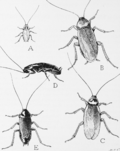Human interactions with insects include both a wide variety of uses, whether practical such as for food, textiles, and dyestuffs, or symbolic, as in art...
83 KB (8,370 words) - 02:42, 8 October 2024
Various cultures throughout Africa utilize insects for many things and have developed unique interactions with insects: as food sources, for sale or trade in...
19 KB (2,511 words) - 22:56, 15 November 2024
Entomophagy (redirect from Eating insects)
interested in entomophagy since 2013. Insects as feed Human interactions with insects Insects in medicine Insects as food Taboo food and drink Deluycker...
10 KB (890 words) - 01:14, 10 January 2025
Moth (category Agricultural pest insects)
Moths are a group of insects that includes all members of the order Lepidoptera that are not butterflies. They were previously classified as suborder...
31 KB (3,115 words) - 05:03, 16 March 2025
Insect ecology is the interaction of insects, individually or as a community, with the surrounding environment or ecosystem. This interaction is mostly...
49 KB (5,944 words) - 14:58, 28 April 2025
Arthropods in film (redirect from Insects in film)
"Beautiful Bugs, Bothersome Bugs, and FUN Bugs: Examining Human Interactions with Insects and Other Arthropods". Anthrozoös. 30 (3): 357–372. doi:10...
21 KB (3,001 words) - 13:35, 7 July 2024
Deathwatch beetle (category Household pest insects)
aged oak timbers, which the beetles prefer. To attract mates, the adult insects create a tapping or ticking sound that can sometimes be heard in the rafters...
28 KB (3,598 words) - 19:30, 31 March 2025
Apitherapy (category Articles with short description)
2016. Berenbaum, May R. (January 1995). Bugs in the System: Insects and Their Impact on Human Affairs. Helix Books. p. 175. ISBN 978-0-201-62499-1. Palmer...
11 KB (1,163 words) - 00:06, 10 May 2025
Flea circus (category Insects in culture)
the Flea (c. 1833) also promoted flea circuses.: 314 Flea performances with military themes such as staged "sword fights" among fleas, were popular in...
12 KB (1,174 words) - 15:36, 11 March 2025
animal species. The insect nervous system consists of a brain and a ventral nerve cord. Most insects reproduce by laying eggs. Insects breathe air through...
134 KB (12,808 words) - 16:39, 26 March 2025
Anthrozoology (redirect from Human-animal interactions)
Anthrozoology, also known as human–animal studies (HAS), is the subset of ethnobiology that deals with interactions between humans and other animals. It is...
9 KB (922 words) - 18:34, 20 April 2025
of meat production Human interactions with insects Insects as feed Insect-based pet food Insects in medicine List of edible insects by country Sustainable...
82 KB (8,337 words) - 11:36, 7 May 2025
appeared in a paper by W.T. Morrill. Human uses of animals Human uses of birds Human interactions with insects Human uses of plants Olden, Julian D.; Vitule...
37 KB (3,637 words) - 02:46, 28 February 2025
Eusociality (redirect from Social Insects)
physical dominance interactions among foundresses of the colony including biting, chasing, and food soliciting. Such interactions create a dominance hierarchy...
74 KB (8,254 words) - 06:06, 18 May 2025
enemies pinpoint a food source. Humans can take advantage of tritrophic interactions in the biological control of insect pests. Plants produce secondary...
44 KB (5,397 words) - 22:55, 31 January 2025
Human interactions with fungi include both beneficial uses, whether practical or symbolic, and harmful interactions such as when fungi damage crops, timber...
37 KB (3,868 words) - 23:44, 24 August 2024
Cyborg (redirect from Robots with human brains)
implant artificial structures into insects during their metamorphic development. The first insect cyborgs, moths with integrated electronics in their thorax...
102 KB (11,465 words) - 04:03, 20 April 2025
Ethnobiology (category Articles with short description)
perspectives in ethnobiology allows for examining complex, dynamic interactions between human and natural systems. Biologists have been interested in local...
19 KB (2,113 words) - 02:14, 18 April 2025
groups to corporations and political states. As such, social interactions between humans have established a wide variety of values, social norms, languages...
266 KB (25,454 words) - 14:50, 15 May 2025
Corpse decomposition (redirect from Human decomposition)
temperatures below 4 °C. Corpse farms are also used to study the interactions of insects with decaying bodies. Payne, Jerry A. (September 1965). "A Summer...
19 KB (2,212 words) - 05:52, 27 March 2025
Mycobiome (redirect from (Human) Mycobiome)
communities new sources of plant energy at the genomic level. Interactions between fungi and insects are incredibly common and most of these relationships are...
24 KB (2,765 words) - 03:45, 4 April 2025
Insect olfaction refers to the function of chemical receptors that enable insects to detect and identify volatile compounds for foraging, predator avoidance...
13 KB (1,613 words) - 00:12, 27 June 2024
Cockroach (redirect from Roach (insect))
(or roaches) are insects belonging to the order Blattodea (Blattaria). About 30 cockroach species out of 4,600 are associated with human habitats. Some...
80 KB (8,383 words) - 22:08, 13 May 2025
considered insects, so over 50% of all described eukaryotes (1.8 million species) are insects (see illustration). With only 950,000 known non-insects, if the...
20 KB (2,179 words) - 16:02, 17 May 2025
Symbiosis (redirect from Interspecific interactions)
include all long-term biological interactions (i.e., mutualism, commensalism, and parasitism), but exclude brief interactions such as predation. In 1949, Edward...
56 KB (6,013 words) - 15:26, 12 May 2025
Scutigera coleoptrata (category Biological control agents of pest insects)
it can live in human homes. It is an insectivore, preying on insects and arachnids by envenomating them (but not dangerous to humans). In 1758, Carl...
15 KB (1,631 words) - 14:13, 10 May 2025
Companion planting (category Articles with short description)
control, including by providing habitat for beneficial insects. Companion planting can reduce insect damage to crops, whether by disrupting pests' ability...
33 KB (3,157 words) - 17:45, 16 May 2025
Carpenter ant (category Articles with short description)
typically eat parts of other dead insects or substances derived from other insects. Common foods for them include insect parts, "honeydew" produced by aphids...
40 KB (4,271 words) - 17:09, 15 May 2025
Insects as feed are insect species used as animal feed, either for livestock, including aquaculture, or as pet food. As livestock feed production uses...
14 KB (1,312 words) - 15:03, 18 April 2024
smelling and subconsciously assessing another human's pheromones. It also affects the sexual attraction of insects and mammals. The major histocompatibility...
50 KB (7,003 words) - 14:24, 16 April 2025


























